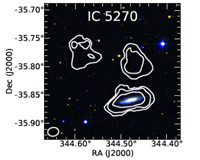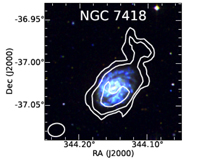First ASKAP paper detects 'cloudy' galaxies
|
Click on the image for more detail. |
27 July 2015
In what is the first scientific ASKAP paper accepted for publication, commissioning data from the Boolardy Engineering Test Array (BETA) has mapped the 21-cm line of neutral hydrogen (HI) in the IC 1459 galaxy group, resolving the HI emission in eleven galaxies and discovering three previously unknown HI clouds, each containing approximately 1 billion solar masses of gas. This first large-scale map of hydrogen emission over 6 square degrees shows that at least 10% of all the gas detected in the IC 1459 group resides outside galaxies.
Over the last year, the ASKAP Commissioning and Early Science team has produced many images of the radio sky using BETA – the first six ASKAP antennas equipped with phased array feeds at the Murchison Radio-astronomy Observatory (MRO) in Western Australia.
BETA commissioning activities provide vital insights into the intricate workings of the new telescope, such as testing the effectiveness of the PAF receivers, in an early indication of what the full ASKAP telescope will be able to achieve.
Using the wide-field capability of the phased array feed (PAF) receivers, the team was able to map, in one go, clouds of intra-galaxy gas – the location of which cannot be predicted easily – within the IC 1459 group. The clouds' detection adds to the body of evidence suggesting significant interactions between galaxies and their environment. Furthermore, all galaxies known to be in this area from the HI Parkes All Sky Survey (HIPASS) were detected, but with 15x better angular resolution.
As the first early wide-field HI imaging performed with BETA, the paper demonstrates the excellent capability of PAFs and what the full ASKAP telescope will be able to do on much larger areas of the sky and to much larger distances. It is also a promising indication for the ASKAP Science Survey Project, WALLABY (the ASKAP HI All-Sky Survey), which will require both sensitivity and resolution to establish how galaxies change over time.
This work is presented in the first ever ASKAP science paper, accepted for publication by the Monthly Notices of the Radio Astronomical Society (MNRAS). The paper is the result of a great collaboration between astronomers from organisations including CSIRO, Swinburne University and UWA/ICRAR, and the ASKAP engineers, system scientists, and Computing team.
Back to Latest ASKAP News page.


